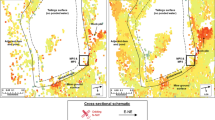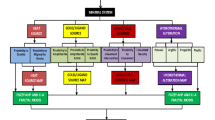Abstract
Coal fires pose a serious threat to the environment and it is important to detect them at an early stage for their control and hazard mitigation. The present study addresses an innovative approach for depth estimation of coal fires using self-potential (SP) method and its inversion through particle swarm optimization (PSO) technique. The suitability of PSO inversion technique for self-potential data has been established using synthetic models of spherical and cylindrical objects, and inclined sheet with large horizontal extent as causative sources. Present study reveals that the geometry of subsurface coal combustion is possibly similar to inclined sheet with relatively large horizontal extension. The depth of coal fires has been estimated using PSO inversion of SP anomaly data over the East Basuria colliery, Jharia coal field, Jharkhand, India with good accuracy. The results of the analysis are compared with borehole lithologic log data which proves efficacy of the PSO inversion technique.






Similar content being viewed by others
References
Bharti AK, Pal SK, Vaish J (2014) Application of Self-potential method for coal fire detection over Jharia Coal field, Indian Geophysical Union, 19–21 November, 2014. Kurukshetra University, Kurukshetra, pp 59–62
Bharti AK, Pal SK, Priyam Piyush, Narayan Satya, Pathak VK, Sahoo SD (2015) Detection of illegal mining over Raniganj Coalfield using electrical resistivity tomography. J Eng Geol Spec Pub 65–69 (Indian Society of Engineering Geology)
Bharti AK, Pal SK, Priam P, Kumar S, Shalivahan, Yadav PK (2016) Subsurface cavity detection over Patherdih colliery, Jharia Coalfield, India using electrical resistivity tomography. Environ Earth Sci 75(5):443. doi:10.1007/s12665-015-5025-z
Bhattacharya BB, Roy N (1981) A note on the use of nomograms for self-potential anomalies. Geophys Prospect 29:102–107
Biswas A, Sharma SP (2014) Optimization of self-potential interpretation of 2-D inclined sheet-type structures based on very fast simulated annealing and analysis of ambiguity. J Appl Geophys 105:235–247
Biswas A, Sharma SP (2015) Interpretation of self-potential anomaly over idealized bodies and analysis of ambiguity using very fast simulated annealing global optimization technique. Near Surf Geophys 13:179–195
Chambers RG (1977) Thermoelectric effects and contact potentials. Phys Educ 12(6):374–380. doi: 10.1088/0031-9120/12/6/006
Chandra D (1992) Jharia coalfields. Geol. Society of India, Bangalore, p 149
Chatterjee RS (2006) Coal fire mapping from satellite thermal IR data—a case example in Jharia Coalfield, Jharkhand, India. ISPRS J Photogramm Remote Sens 60(2):113–128
Clerc M (1999) The swarm and the queen: towards a deterministic and adaptive particle swarm optimization. In: Angeline PJ, Michalewicz Z, Schoenauer M, Yao X, Zalzala A (eds) Proceedings of the Congress of Evolutionary Computation, vol 3. IEEE Press, Washington DC, pp 1951–1957
Clerc MA, Kennedy J (2002) The particle swarm-explosion, stability, and convergence in a multidimensional complex space. IEEE Trans Evol Comput 6(1):58–73
Duba A (1977) Electrical conductivity of coal and coal char. Fuel 56:441–443
Eberhart RC, Shi Y (2000) Comparing inertia weights and constriction factors in particle swarm optimization. In: Proceedings of the 2000 IEEE Congress on Evolutionary Computation. IEEE Press, Piscataway, NJ, pp. 84–88
Fernández Martínez JL, García Gonzalo E (2008) The generalized PSO: a new door to PSO evolution. J Artif Evol Appl 1–15. doi:10.1155/2008/861275
Fernández Martínez JL, García Gonzalo E (2009) The PSO family: deduction, stochastic analysis and comparison. Swarm Intell 3(4):245–273 (Special Issue on Particle swarm)
Fernández Martínez JL, García Gonzalo E (2011) Stochastic stability analysis of the continuous and discrete PSO models. IEEE Trans Evol Comput 15(3):405–423
Fernández Martínez JL, García Gonzalo E, Fernández Álvarez JP, Kuzma HA, Menéndez Pérez CO (2010a) PSO: a powerful algorithm to solve geophysical inverse problems: application to a 1D-DC resistivity case. J Appl Geophys 71:13–25
Fernández Martínez JL, García Gonzalo E, Fernández Álvarez JP, Kuzma HA, Menéndez Pérez CO (2010b) PSO: a powerful algorithm to solve geophysical inverse problems: Application to a 1D-DC resistivity case. J Appl Geophys 71(1):13–25. doi:10.1016/j.jappgeo.2010.02.001
Heppner F, Grenander U (1990) A stochastic nonlinear model for coordinated bird flocks. In: Krasner S (ed) The ubiquity of chaos. AAAS Publications, Washington, DC
Hooper RL (1987) Factors affecting the magnetic susceptibility of baked rocks above a burned coal seam. Int J Coal Geol 9:157–169
Ide TS, Crook N, Orr FM (2011) Magnetometer measurements to characterize a subsurface coal fire. Int J Coal Geol 87(3):190–196
Kennedy J, Eberhart RC (1995) Particle swarm optimization. IEEE Press, Piscataway, pp 1942–1948
King A (1987) Cindered coal detection using transient electromagnetic methods. Geoexploration 24:367–379
Kumar S, Pal SK, Vaish J, Shalivahan (2015) Utilization of magnetic gradient method for coal fire mapping of Chatabad Area, a Part of Jharia Colafield, India. J Eng Geol Spec Pub 170–176 (Indian Society of Engineering Geology)
Meng Q, Ma X, Zhou Y (2014) Forecasting of coal seam gas content by using support vector regression based on particle swarm optimization. J Nat Gas Sci Eng 21:71–78
Momeni E, Armaghani DJ, Hajihassani M, Amin MFM (2015) Prediction of uniaxial compressive strength of rock samples using hybrid particle swarm optimization-based artificial neural networks. Measurement 60:50–63
Murthy BVS, Haricharan P (1985) Nomograms for the complete interpretation of spontaneous potential profiles over sheet like and cylindrical 2D structures. Geophysics 50:1127–1135
Naudet V, Fernandez-Martinez JL, Garcia-Gonzalo E, Fernandez-Alvarez JP (2008) Estimation of water table from self-potential data using Particle Swarm Optimization (PSO). Society of Exploration Geophysicists (SEG) Annual Meeting, Las Vegas, Nevada, pp 1203–1207
Pal SK, Vaish J, Kumar S, Bharti AK (2016) Coalfire mapping of East Basuria Colliery, Jharia coal field using Vertical Derivative Technique of Magnetic data. J Earth Syst Sci 125(1):165–178
Panigrahi DC, Sahu HB (2004) Classification of coal seams with respect to their spontaneous heating susceptibility—a neural network approach. Geotech Geol Eng 22:457–476
Pekşen E, Yas T, Kayman AY, Özkan C (2011) Application of particle swarm optimization on self-potential data. J Appl Geophys 75(2):305–318
Prakash A, Saraf AK, Gupta RP, Dutta M, Sundaram RM (1995) Surface thermal anomalies associated with underground fires in Jharia Coal Mines India. Int J Remote Sens 16(12):2105–2109
Prakash A, Gupta RP, Saraf AK (1997) A Landsat TM based comparative study of surface and subsurface fires in the Jharia Coalfield India. Int J Remote Sens 18(11):2463–2469
Ram Babu HV, Rao DA (1988) Inversion of self-potential anomalies in mineral exploration. Comput Geosci 14:377–388
Rees WG (2001) Physical Principles of Remote Sensing, 2nd edn. Cambridge University Press, Cambridge
Revil A, Jardani A (2013) The self-potential method, theory and applications in environmental geosciences. Cambridge University Press, Cambridge
Revil A, Naudet V, Nouzaret J, Pessel M (2003) Principles of electrography applied to self-potential electrokinetic sources and hydrogeological applications. Water Resour Res 39(5):1114. doi:10.1029/2001WR000916
Revil A, Karaoulis M, Srivastava S, Byrdina S (2013) Thermoelectric self-potential and resistivity data localize the burning front of underground coal fires. Geophysics 78(5):B259–B273
Reynolds CW (1987) Flocks, herds and schools: a distributed behavioral model. ACM Siggraph Comput Graph 21(4):25–34
Roy SVS, Mohan NL (1984) Spectral interpretation of self-potential anomalies of some simple geometric bodies. Pure appl Geophys 78:66–77
Sahu HB, Mahapatra SS, Sirikasemsuk K, Panigrahi DC (2011) A discrete particle swarm optimization approach for classification of Indian coal seams with respect to their spontaneous combustion susceptibility. Fuel Process Technol 92(3):479–485
Santos FAM (2010) Inversion of self-potential of idealized bodies’ anomalies using particle swarm optimization. Comput Geosci 36(9):1185–1190
Saraf AK, Prakash A, Sengupta S, Gupta RP (1995) Landsat TM data for estimating ground temperature and depth of subsurface fire in Jharia Coalfield India. Int J Remote Sens 16(12):2111–2124
Schutte JF, Groenwold AA (2005) A study of global optimization using particle swarms. J Global Optim 31:93–108
Shaw R, Srivastava S (2007) Particle swarm optimization: a new tool to invert geophysical data. Geophysics 72:F75–F83
Shi Y, Eberhart RC (1998) A modified particle swarm optimizer. In: Proceedings of the 1998 IEEE World Congress on Computational Intelligence. IEEE Press, Piscataway, NJ, pp 69–73
Singh KKK, Singh KB, Lokhande RD, Prakash A (2004) Multielectode Resistivity imaging technique for the study of coal seam. J Sci Ind Res 63:927–930
Singh AK, Singh RVK, Singh MP, Chandra H, Shukla NK (2007) Mine fire gas indices and their application to Indian underground coal mine fires. Int J Coal Geol 69(3):192–204
Singh BB, Srivardhan V, Pal SK, Kanagaraju SK, Kumar S, Vaish J (2015) Particle swarm optimization inversion of self potential anomaly for detecting coal fires, a case study - Jharia Coal Field. Third sustain earth sci conf Celle. doi:10.3997/2214-4609.201414282
Srivastava S, Agarwal BNP (2009) Interpretation of self-potential anomalies by enhanced local wave number technique. J Appl Geophys 68:259–268
Sternberg R, Lippincott C (2004) Magnetic surveys over clinkers and coal seam fires in Western North Dakota. Presentation at the Denver Annual Meeting of the Geological Society of America, Denver, Colorado, U.S.A., 7-10 October 2004
Sternberg R, Sparks A, Knutson O (2008) Magnetic surveys over burning and remediated coal seam fires in Western North Dakota. In: Proceedings of the Symposium on the Application of Geophysics to Engineering and Environmental Problems: SAGEEP, 21. doi:10.2113/1.2963279
Tarantola A (2005) Inverse Problem Theoryand Methods for Model Parameter Estimation. Soc Ind Appl Math 359
Trelea IC (2003) The particle swarm optimization algorithm: convergence analysis and parameter selection. Inform Proc Lett 85:317–325
Vaish J, Pal SK (2013) Interpretation of Magnetic Anomaly data over East Basuria region using an Enhanced Local Wavenumber (ELW) Technique, 10th Biennial International Conference & Exposition, Society of Petroleum Geophysicists conference, Kochi, Kerala, India, 23–25 November, 2013, P110
Vaish J, Pal SK (2015a) Subsurface coal fire mapping of East Basuria Colliery. Jharkhand J Geol Soc India 86(4):438–444
Vaish J, Pal SK (2015b) Geological mapping of Jharia Coalfield, India using GRACE EGM2008 gravity data: a vertical derivative approach. Geocarto Int 30(4):388–401
Vaish J, Pal SK (2015c) Subsurface Coal fire mapping of Patherdih Colliery, a part of Jharia coal field, India. J Geol Soc India (in press)
Wilson EO (1975) Sociobiology: the new synthesis. Belknap Press, Cambridge
Yüngül S (1950) Interpretation of spontaneous polarization anomalies caused by spheroidal orebodies. Geophysics 15(2):237–246
Zhang X, Van Genderen JL, Kroonenberg SB (1997) A method to evaluate the capability of Landsat-5 TM band 6 data for sub-pixel coal fire detection. Int J Remote Sens 18(15):3279–3288
Zhang-guo W, Ya-li K, Zhe L, Chang-sheng S (2009) Model of coal product structure based on particle swarm optimization algorithm. Procedia Earth Planet Sci 1(1):640–647
Acknowledgments
We are thankful to Prof. James W. LaMoreaux, Editor-in-Chief and the anonymous Referees for their valuable suggestions towards improvement of the manuscript. Authors are thankful to Department of Science of Technology (DST), Govt. of India for funding the project (SB/S4/ES-640/2012) on geotechnical characterization of Jharia coal field area using Geophysical techniques. Authors wishe to thank to the Department of Science of Technology (project no. SR/FST/ESI-104/2010) and University Grant Commission (project no. F.560/1/CAS/2009(SAP-I)) Govt. of India for using instrumental facilities under these projects. The authors wish to thank to Director, ISM and HOD, Department of Applied Geophysics, ISM, Dhanbad for their support in this study. Authors are also thankful to Mr. D. N. Tiwari, East Basuria Colliery for the support at various stages of this study.
Author information
Authors and Affiliations
Corresponding author
Rights and permissions
About this article
Cite this article
Srivardhan, V., Pal, S.K., Vaish, J. et al. Particle swarm optimization inversion of self-potential data for depth estimation of coal fires over East Basuria colliery, Jharia coalfield, India. Environ Earth Sci 75, 688 (2016). https://doi.org/10.1007/s12665-015-5222-9
Received:
Accepted:
Published:
DOI: https://doi.org/10.1007/s12665-015-5222-9




